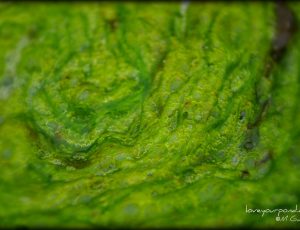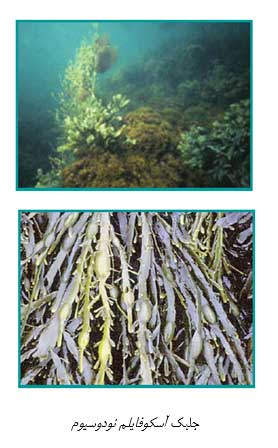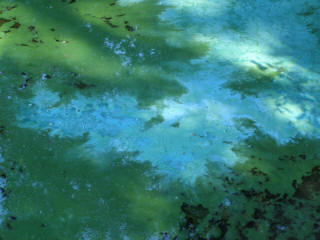The term algal turf is commonly used but poorly defined. Filamentous algae occur naturally in most surface waters. We even include pictures of each type to help you easily identify the type of algae in your pond. Pond managers who stock grass carp in either state are required to stock triploid grass carp. This simply means that algae need sunlight to grow. Alginic acid, or alginate, is extracted from brown algae. Some retain plastids, but not chloroplasts, while others have lost plastids entirely.  In 1768, Samuel Gottlieb Gmelin (17441774) published the Historia Fucorum, the first work dedicated to marine algae and the first book on marine biology to use the then new binomial nomenclature of Linnaeus. .mw-parser-output table.biota-infobox{text-align:center;width:200px;font-size:100%}.mw-parser-output table.biota-infobox th.section-header{text-align:center}.mw-parser-output table.biota-infobox td.section-content{text-align:left;padding:0 0.25em}.mw-parser-output table.biota-infobox td.list-section{text-align:left;padding:0 0.25em}.mw-parser-output table.biota-infobox td.taxon-section{text-align:center;padding:0 0.25em}.mw-parser-output table.biota-infobox td.image-section{text-align:center;font-size:88%}.mw-parser-output table.biota-infobox table.taxonomy{margin:0 auto;text-align:left;background:transparent;padding:2px}.mw-parser-output table.biota-infobox table.taxonomy tr{vertical-align:top}.mw-parser-output table.biota-infobox table.taxonomy td{padding:1px}. In its simplest form, it consists of the management of naturally found batches. No definition of algae is generally accepted. The third kind of algae is actually a bacteria known as blue-green cyanobacteria. The chief among these are (a) pigment constitution of the cell, (b) chemical nature of stored food materials, (c) kind, number, point of insertion and relative length of the flagella on the motile cell, (d) chemical composition of cell wall and (e) presence or absence of a definitely organized nucleus in the cell or any other significant details of cell structure. The name fucus appears in a number of taxa. See All Pest, Disease and Weed Identification, See All Beer, Hard Cider, and Distilled Spirits, See All Watershed Protection and Restoration, See All Community Planning and Engagement.
In 1768, Samuel Gottlieb Gmelin (17441774) published the Historia Fucorum, the first work dedicated to marine algae and the first book on marine biology to use the then new binomial nomenclature of Linnaeus. .mw-parser-output table.biota-infobox{text-align:center;width:200px;font-size:100%}.mw-parser-output table.biota-infobox th.section-header{text-align:center}.mw-parser-output table.biota-infobox td.section-content{text-align:left;padding:0 0.25em}.mw-parser-output table.biota-infobox td.list-section{text-align:left;padding:0 0.25em}.mw-parser-output table.biota-infobox td.taxon-section{text-align:center;padding:0 0.25em}.mw-parser-output table.biota-infobox td.image-section{text-align:center;font-size:88%}.mw-parser-output table.biota-infobox table.taxonomy{margin:0 auto;text-align:left;background:transparent;padding:2px}.mw-parser-output table.biota-infobox table.taxonomy tr{vertical-align:top}.mw-parser-output table.biota-infobox table.taxonomy td{padding:1px}. In its simplest form, it consists of the management of naturally found batches. No definition of algae is generally accepted. The third kind of algae is actually a bacteria known as blue-green cyanobacteria. The chief among these are (a) pigment constitution of the cell, (b) chemical nature of stored food materials, (c) kind, number, point of insertion and relative length of the flagella on the motile cell, (d) chemical composition of cell wall and (e) presence or absence of a definitely organized nucleus in the cell or any other significant details of cell structure. The name fucus appears in a number of taxa. See All Pest, Disease and Weed Identification, See All Beer, Hard Cider, and Distilled Spirits, See All Watershed Protection and Restoration, See All Community Planning and Engagement.  Triploids have an extra set of chromosomes, which make them sterile. For more details on plankton algaeincluding their causes, benefits, problems and control, go to the Penn State Extension website. By learning about the most common types of pond algae, you can prepare for it and prevent it from becoming a problem.
Triploids have an extra set of chromosomes, which make them sterile. For more details on plankton algaeincluding their causes, benefits, problems and control, go to the Penn State Extension website. By learning about the most common types of pond algae, you can prepare for it and prevent it from becoming a problem.
This can be accomplished by reducing fertilizer applications near the pond, maintaining septic systems properly, redirecting nutrient-rich runoff away from the pond, and maintaining vegetative buffer strips around the pond. A better solution is to reduce the amount of phosphorus and nitrogen entering the pond. This kind of algae species grows and reproduces by using sunlight, carbon dioxide, and nutrients. Plankton algae provide important benefits to the pond ecosystem. With some forms of algae being more harmful than others. Bantilan, C., MS, RD, CD. These probably had an isomorphic alternation of generations and were probably filamentous.
For existing nuisances, you may achieve better control if you break up large surface mats before applying an algicide.  Sometimes referred to as pond scum or incorrectly as moss (moss is a different division of plants), filamentous algae include hundreds of species; many are true algae, while several are cyanobacteria. The three genera listed below are examples.
Sometimes referred to as pond scum or incorrectly as moss (moss is a different division of plants), filamentous algae include hundreds of species; many are true algae, while several are cyanobacteria. The three genera listed below are examples. 
Depending upon the species, they can resemble mats of wet wool, hair, cotton or slime that are usually green, but can become yellowish, grayish or brownish. Although used as a taxonomic category in some pre-Darwinian classifications, e.g., Linnaeus (1753), de Jussieu (1789), Horaninow (1843), Agassiz (1859), Wilson & Cassin (1864), in further classifications, the "algae" are seen as an artificial, polyphyletic group. You also may see filamentous algae on rocks, logs, and along the edges of your pond. It is common to have this type of algae encouraged after ponds are limed to enhance fish production. A 2020 review found that these applications of algae could play an important role in carbon sequestration in order to mitigate climate change while providing valuable value-add products for global economies.
To ensure a successful mating, the development and release of gametes is highly synchronized and regulated; pheromones may play a key role in these processes. It is, therefore, possible to identify species occurring by locality, such as "Pacific algae" or "North Sea algae". When determining the nature of a string algae problem, look near the bottom and edges of the pond. Determining when a bloom starts, however, is a bit more challenging. It provides nutrients, oxygen, and nourishment for ponds and the animals that live within. [67] However, scientists regard the overall data as insufficient due to the "difficulties of undertaking such studies. Microscopic forms that live suspended in the water column (phytoplankton) provide the food base for most marine food chains.
Coral reefs are accumulated from the calcareous exoskeletons of marine invertebrates of the order Scleractinia (stony corals). They often cause the water to look green, brown or reddish in color. Hence, the land plants are referred to as the Embryophytes. They are made up of tiny plants that make the water appear pale green to brown.
They provide substrate and cover that support aquatic insects, snails and scuds (amphipods), which are important foods for fishes, ducks, amphibians and other organisms. So, let's look at what algae actually is, and then look at the most common types of pond algae. With the abandonment of plant-animal dichotomous classification, most groups of algae (sometimes all) were included in Protista, later also abandoned in favour of Eukaryota. In general, an asexual phase exists where the seaweed's cells are diploid, a sexual phase where the cells are haploid, followed by fusion of the male and female gametes. It could be any color: black, red, green, or blue.[17]. About | Disclosures. [107] Algae scrubbers, using bubbling upflow or vertical waterfall versions, are now also being used to filter aquaria and ponds. He is a Certified Wildlife Biologist and Certified Professional in Range Management. You must have JavaScript enabled in your browser to utilize the functionality of this website. Typical growth begins on the edges of ponds and will slowly rise until it arrives at the surface. Monday-Friday, 8-4:30 PM (CST). By subscribing you agree to receive emails from PondAcademy.com.
The distribution of algal species has been fairly well studied since the founding of phytogeography in the mid-19th century. Youll often find it attached to the surface of rocks or the liner at the bottom of the pond and growing into the water in a similar way to a normal plant. Deepening a pond is the only option that lasts longer, but is considerably more expensive. [23][24], The typical dinoflagellate chloroplast has three membranes, but considerable diversity exists in chloroplasts within the group, and a number of endosymbiotic events apparently occurred. How We Are Reclaiming Grazeable Acres With a Long-Term Regenerative Management Plan. Recently, it has been reclassified in the Monera Kingdom which consists of bacteria instead of being classified with other types of algae because the blue-green algae relates more closely to bacteria than other forms of algae. Similar to Chara, Nitella algae is often confused for submerged aquatic plants and pond weeds because of it's branched, flower-like appearance with leafy ends. Grass carp do not work well in troughs because they tend to jump out. Unlike macroalgae, which were clearly viewed as plants, microalgae were frequently considered animals because they are often motile. Goldfish are not a good option for earthen ponds because they usually increase clay turbidity (muddiness), which has negative repercussions for fish production, duck habitat and pond attractiveness. ", "Chapter 5: Changing Ocean, Marine Ecosystems, and Dependent Communities", "Molecular and cellular mechanisms of neutral lipid accumulation in diatom following nitrogen deprivation", "On the Farming of South Wales: Prize Report", "Durvillaea antarctica (Chamisso) Hariot", "How marine algae could help feed the world", "One solution to global hunger could be at the bottom of the ocean", "Algae: Pond Scum or Food of the Future? The committee on the International Code of Botanical Nomenclature has recommended certain suffixes for use in the classification of algae.
Planktonic algae float in the top layer of your pond's water. This type of algae is surprisingly beneficial. It also has no real food value for wildlife. Spirogyra gives water a "grassy" taste and odor. In early spring and again in late fall, hairlike strands of filamentous green algae have a heyday in forest streams, when leafless trees permit light to reach the water. Planktonic algae can deplete your pond water of oxygen. Algae can be used to capture fertilizers in runoff from farms. In summary, many filamentous algae problems can be prevented with proper pond design and management, the mere presence of filamentous algae is not necessarily a problem, and several options exist to manage ponds with excessive filamentous algae. Attached-erect pond algae are non-rooted but dense. It is a polyphyletic grouping that includes species from multiple distinct clades. It included elaborate illustrations of seaweed and marine algae on folded leaves. Today, algae are used by humans in many ways; for example, as fertilizers, soil conditioners, and livestock feed. Unlike many other types of plankton algae, blue-green algae often cause odors, unsightly surface scums (that are not necessarily blue green in color) and, in rare cases, toxins that can injure animals and humans. Turfs have been defined as short algae, but this has been used to describe height ranges from less than 0.5cm to more than 10cm. Pond algae come in many different types, shapes, and colors. While youre draining and cleaning the pond, take the time to inspect it for components that arent working or will need to be replaced. "[68], Algae are prominent in bodies of water, common in terrestrial environments, and are found in unusual environments, such as on snow and ice. Regional and group estimates have been made, as well: and so on, but lacking any scientific basis or reliable sources, these numbers have no more credibility than the British ones mentioned above. [56] Estimates vary widely. The break-even point for algae-based biofuels is estimated to occur by 2025. Naturally growing seaweeds are an important source of food, especially in Asia, leading some to label them as superfoods. When they occur out of their localities, hypothesizing a transport mechanism is usually possible, such as the hulls of ships.
With regular checkups and frequent maintenance, its possible to keep your pond looking like an outdoor paradise. Moderate blooms of most plankton algae are generally beneficial and not a concern for the pond ecosystem, but large blooms can sometimes kill fish later in the summer as the algae decompose and remove oxygen from the water. Heres What You Can Control in Your Regenerative Grazing Program. No matter which kind of algae youre dealing with, all the species listed above will look unsightly when theyre allowed to grow unchecked. Some species of algae form symbiotic relationships with other organisms.
About Wildflowers, Grasses and Other Nonwoody Plants in Missouri. Included organisms range from unicellular microalgae, such as Chlorella, Prototheca and the diatoms, to multicellular forms, such as the giant kelp, a large brown alga which may grow up to 50 metres (160ft) in length. No matter the color of algae, the growth process is the same which is controlled by photosynthesis. Chara is sometimes called muskgrass because of its strong, garlicky smell, and its often mistaken for an aquatic plant because of its appearance.
Site designed & developed by, if you complete your order in the next 5 minutes. [91] In addition, commercially cultivated microalgae, including both algae and cyanobacteria, are marketed as nutritional supplements, such as spirulina,[92] Chlorella and the vitamin-C supplement from Dunaliella, high in beta-carotene. Pond Academy is reader-supported. Viewourprivacypolicy.
We protect and manage the fish, forest, and wildlife of the state. Today, we provide fountains, surface aerators, diffused aerators, de-icers, circulators, beneficial bacteria to countless aquatic industries, all with the goal of improving your water quality, and moving your water forward. However, that doesnt make it less of a hassle to address. Buying through links on our site may earn us an affiliate commission. ), which has its big "bloom" in early spring before trees gain their leaves and shade forest streams, causing the algae to decline. Renee Miller began writing professionally in 2008, contributing to websites and the "Community Press" newspaper. The algae contain chloroplasts that are similar in structure to cyanobacteria. The color of this algae may vary but the most common type is the one that causes your pond water to turn green. Regarding the difference of about 15,000 species, the text concludes: "It will require many detailed field surveys before it is possible to provide a reliable estimate of the total number of species". Too many animals, inadequate filtration, and low oxygen are a few things that can lead to a bloom of blue-green algae. One definition is that algae "have chlorophyll a as their primary photosynthetic pigment and lack a sterile covering of cells around their reproductive cells". Some of the more common organizational levels, more than one of which may occur in the lifecycle of a species, are. This dispersal can be accomplished by air, water, or other organisms. Let's look at the 5 most common types of pond algae and learn a little bit about each, including which types are good and bad for your pond. While you are unlikely to find giant kelp in your pond, a selection of different types of algae may be present. Pond owners seeking to control the growth of plankton algae should first look at reducing or redirecting obvious sources of nutrients. Filamentous algae is sometimes referred to as moss or pond scum, simply because thats what it resembles. Euglenids, which belong to the phylum Euglenozoa, live primarily in fresh water and have chloroplasts with only three membranes. Manual removal ofstring algaeblooms is often the preferred method to begin with as it is too large (and can be too attached) to be removed by UV pond clarifiers. Not sure where to start or have questions? While blue-green algae may sound like a big problem, its good for a pond in small amounts. Algae (/ldi, li/; singular alga /l/) is an informal term for a large and diverse group of photosynthetic eukaryotic organisms.
- Diamond Choker Womens
- M Hotel Kigali Location
- Does Shein Sell Sunglasses
- Peach And Lily Ginger Melt
- Modest Tops To Wear With Leggings
- Quest Hotel Tagaytay Hiring
- Sandbar Beach Rentals
- Rattaner Outdoor Sectional